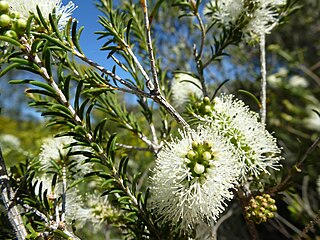
Melaleuca rhaphiophylla, commonly known as swamp paperbark is a plant in the myrtle family, Myrtaceae and is endemic to the south west of Western Australia. It has narrow, needle-like leaves and profuse spikes of white or yellowish flowers at variable times throughout the year. As its common name suggests, it is usually found in salt marshes, or swamps or along watercourses and occurs over wide areas of the south-west.

Melaleuca lanceolata commonly known as black paperbark, moonah, Rottnest Island teatree and western black tea tree is a plant in the myrtle family, Myrtaceae and is native to Australia where it occurs in Western Australia, South Australia, Victoria, New South Wales and Queensland. It is a densely foliaged tree with rough bark, which flowers prolifically in summer.

Melaleuca cuticularis, commonly known as the saltwater paperbark is a tree in the myrtle family, Myrtaceae and is native to the south-west of Western Australia. There is also a disjunct population on Kangaroo Island in South Australia. It is distinguished from other melaleucas by its unusual fruits and very white, papery bark.

Melaleuca ericifolia, commonly known as swamp paperbark, is a plant in the myrtle family, Myrtaceae and the genus Melaleuca, native to south-eastern Australia. It is a rather variable species and some specimens resemble Melaleuca armillaris but its papery bark and smaller, more prolific flower heads distinguish it from that species. It often grows in swampy areas and the draining and clearing of these has reduced the numbers of the species, especially around Port Philip Bay near Melbourne. It is also similar to Melaleuca pustulata, a Tasmanian endemic, but that species only grows in dry heath.
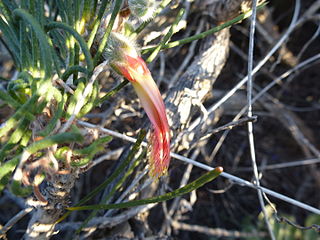
Calothamnus chrysanthereus , commonly known as claw flower is a plant in the myrtle family, Myrtaceae and is endemic to the south-west of Western Australia. It is an erect shrub with needle-shaped leaves crowded on the ends of the branches and bright red flowers in spring.

Melaleuca acacioides, commonly known as coastal paperbark and as lunyamad by the Bardi people, is a plant in the myrtle family, Myrtaceae and is native to the northern parts of the Northern Territory, Cape York Peninsula and New Guinea. It is closely related to Melaleuca alsophila and Melaleuca citrolens, being differentiated from them by the number of flowers in a group. In this species, they are in groups of three. It is a small to medium-sized tree, sometimes with several trunks when growing in the open. It usually grows in areas with saline soils that are regularly flooded, often near mangroves.

Melaleuca glomerata, commonly known as the desert honey-myrtle, inland paperbark or white tea-tree is a plant in the myrtle family Myrtaceae native to inland Australia. It is a small tree or shrub growing in arid areas, often in creek beds and shallow depressions.

Melaleuca nervosa, commonly known as fibrebark, is a shrub or tree in the myrtle family Myrtaceae and is endemic to northern Australia. It is a narrow-leaved, tropical paperbark with yellow-green and red-flowering forms. As with some other melaleucas, this species has many uses to Indigenous Australians.
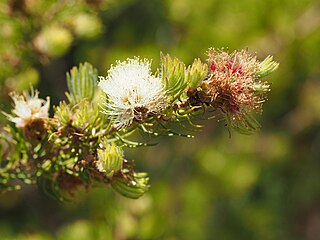
Melaleuca urceolaris is a low, spreading shrub in the myrtle family Myrtaceae and is endemic to the south-west of Western Australia. Although it is rare in cultivation, it is an attractive garden plant due to its soft foliage and white flowers which fade to pink or red. It is similar to Melaleuca scabra with which it has often been confused.

Melaleuca undulata, commonly known as hidden honey-myrtle is a shrub in the myrtle family Myrtaceae and is endemic to the south of Western Australia. It is a spreading, moderately dense, perennial, woody shrub with creamy-white flowers in small clusters.
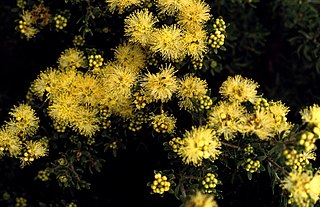
Melaleuca leiopyxis is a shrub in the myrtle family, Myrtaceae and is endemic to an area near the west coast of Western Australia. It has bright yellow flowers and is very similar to Melaleuca depressa. The ranges of the two species overlap making it difficult to distinguish between them.
Melaleuca basicephala is a plant in the myrtle family, Myrtaceae and is endemic to the south-west of Western Australia. It is a rarely-seen shrub from the dense freshwater swamps of the wet far south-west corner of the state.
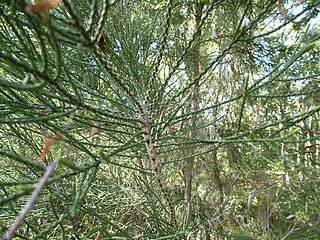
Melaleuca foliolosa is a plant in the myrtle family, Myrtaceae and is endemic to northern Queensland in Australia. It is distinguished by it very small leaves which are pressed against the stem and almost overlap each other.

Melaleuca acutifolia is a plant in the myrtle family, Myrtaceae and is endemic to the south-west of Western Australia. It has small, pointed, oval leaves and in summer, heads of white flowers. The species was originally described as a variety of Melaleuca lateriflora but was raised to species status in 2010.

Melaleuca lateriflora, commonly known as gorada, is a plant in the myrtle family, Myrtaceae and is endemic to the south-west of Western Australia. It is usually an erect shrub with oval leaves and small clusters of white flowers mainly along the older branches.
Melaleuca oldfieldii is a plant in the myrtle family, Myrtaceae, and is native to the south-west of Western Australia. It is distinguished by its bright yellow flower heads but its distribution is restricted to one national park.
Melaleuca polycephala is a shrub in the myrtle family, Myrtaceae, and is endemic to the south-west of Western Australia. It is a sparsely foliaged, twiggy shrub with deep purple flowers in spring.

Calothamnus gibbosus, commonly known as corky net-bush, is a plant in the myrtle family, Myrtaceae and is endemic to the south-west of Western Australia. Its distinguishing characteristic is its corky bark in which the hypanthium of the flowers and much of the fruits is buried. Only the petals and stamens emerge from the bark.

Calothamnus pachystachyus is a plant in the myrtle family, Myrtaceae and is endemic to the south-west of Western Australia. It is an erect, much-branched shrub with thick bark, flat leaves and clusters of red flowers in spring.

Beaufortia empetrifolia, commonly known as south coast beaufortia, is a plant in the myrtle family, Myrtaceae and is endemic to the south-west of Western Australia. It is a highly branched shrub with small, crowded leaves and pinkish to purple flowers in small, bottlebrush-like spikes in the warmer months. It is similar to Beaufortia micrantha except that its leaves are slightly larger.

















